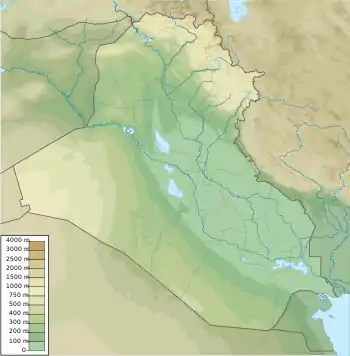Bakr Awa
Bakr Awa is a tell, or archaeological settlement mound, in Iraq. It is located near Halabja in the Shahrizor Plain in Iraqi Kurdistan. The site is 40 metres (130 ft) high and consists of a central settlement mound (277 meters by 216 meters) surrounded by a lower city measuring 800 by 600 metres (2,600 ft × 2,000 ft).[1]
 | |
 Shown within Iraq | |
| Location | Iraq |
|---|---|
| Region | Sulaymaniyah Governorate |
| Coordinates | 35°13′14.002″N 45°56′26.002″E |
| Type | tell |
| Site notes | |
| Excavation dates | 1927; 2014; 2013; 2011; 2010; 1961; 1960 |
| Archaeologists | Peter A. Miglus, Ephraim Avigdor Speiser |
The site was first investigated in 1927 by Ephraim Speiser as part of a more general study of the area.[2] Speiser proposed identifying the site as Atlila, which was subsequently renamed to Dur-Assur. [3] Subsequent excavations took place in 1960 and 1961 by archaeologists from the Iraqi Directorate-General of Antiquities. Three small cuneiform tablets were found.[4][5] The excavators mentioned that they expanded a trench dug by George Martin Lees 40 years before. In 2009 the site was surveyed. New excavations were started in 2010, with subsequent seasons taking place in 2011, 2013, and 2014.[6] The survey and the 2010-2014 excavations were undertaken by a team from the University of Heidelberg.[1]
The oldest excavated layers date to the third millennium BC and are contemporary with the Jemdet Nasr and Early Dynastic periods. A small temple dates to the Akkadian period. Large houses and tombs were recovered from the second millennium BC occupation layers. Occupation continued into the Late Bronze Age. Material culture from these layers showed links with the Hurrian and Kassite cultures. Iron Age occupation at Bakr Awa dates to the Neo-Assyrian period and the Achaemenid Empire. A Sassanian occupation at Bakr Awa is likely, but hasn't been proven beyond doubt. Islamic period occupation ranges from the Abbasid period into the Ottoman period. The site continues to be occupied today.[1]
Economy
In the Early Dynastic period, the economy was nomadic and based on sheep and goat (74.1%), mainly killed for meat. There were also remains of cattle and more rarely equids.[7]
In the Akkadian period, the economy shifted from nomadic to more sedentary and pastoral, introducing new elements as pig and poultry breeding as well as wild animal hunting.[7]
Gallery
 September 18, 2014. Excavations at Bakr Awa
September 18, 2014. Excavations at Bakr Awa A fragment of a clay tablet with a cuneiform inscription, unearthed in September 2014 at Bakr Awa
A fragment of a clay tablet with a cuneiform inscription, unearthed in September 2014 at Bakr Awa A 1st-millennium BCE, probably Neo-Assyrian, grave at Bakr Awa
A 1st-millennium BCE, probably Neo-Assyrian, grave at Bakr Awa Fragments of pottery unearthed at Bakr Awa
Fragments of pottery unearthed at Bakr Awa
See also
References
- "Bakr Awa". www.assur.de. Retrieved 2017-11-10.
- Speiser, E. A., "Southern Kurdistan in the Annals of Ashurnasirpal and Today", Annual of the American Schools of Oriental Research, vol. 8, pp. 1–41, 1926-1927
- Rafał A. Fetner, "Human remains from Bakr Awa, Iraqi Kurdistan,2014", Bioarchaeology of the Near East, vol. 9, pp. 55–59, 2015
- Matouš, L., "L’almanach de Bakr-Awa.", Sumer, vol. 17, pp. 17–66, 1961 (french)
- Muhammad Baqir al-Husaini, "The Excavations at Tel Bakr-Awa", Sumer, vol. 18, no. 1-2, pp. 141-164, 1962 (arabic)
- Peter A. Miglus et al., "Excavation at Bakr Awa 2010 and 2011", Iraq, vol. 75, pp. 43-88, 2013
- Piątkowska-Małecka, Joanna (2015). "Different types of animal economy at Bakr Awa, Iraq, in the Bronze Age". S2CID 55625122. Retrieved 2021-07-06.
Further reading
- Miglus, Peter (2016). "About Bakr Awa". The archaeology of the Kurdistan Region of Iraq and adjacent regions. K. Kopanias, John MacGinnis, Archaeopress. Oxford. pp. 229–239. ISBN 978-1-78491-394-6. OCLC 976020982.
External links
| Wikimedia Commons has media related to Bakr Awa. |